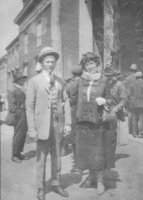 | Back to e-WV
| Back to e-WV
 The West Virginia Encyclopedia
The West Virginia Encyclopedia
 | Back to e-WV
| Back to e-WV
 The West Virginia Encyclopedia
The West Virginia Encyclopedia

The 1922 treason trial of labor leader Bill Blizzard followed the 1921 Miners’ March and the resulting Battle of Blair Mountain. At the time of the battle Blizzard was president of United Mine Workers District 17’s Subdistrict Two, based in St. Albans. The members of the subdistrict were known for their belligerence toward both company and UMW officials, and some observers (including the activist, Mother Jones) believed Blizzard’s incendiary character would escalate the conflict. District 17 leaders Fred Mooney and Frank Keeney left the state during the battle in order to avoid arrest, but Blizzard remained. He played a decisive role in convincing the marchers to surrender once federal troops appeared upon the scene. The state accused several union leaders, including Blizzard, and many of the marchers with treason against the state of West Virginia and other charges, interpreting the miners’ armed march as an insurrection against the state.
Prosecution and defense attorneys agreed to move the trials to Charles Town, Jefferson County, in the Eastern Panhandle and far from the coalfields. Coal company attorneys composed the prosecution team. Thomas Townsend, former Kanawha County prosecuting attorney, led the defense. The prosecution chose to try Blizzard first, believing that the State of West Virginia v. William Blizzard was the strongest of the treason cases.
The trial centered on a discussion of Blizzard’s location during the movement toward Blair Mountain. Prosecution witnesses claimed that Blizzard had shadowed the marchers, periodically requesting reports and issuing orders. The defense presented witnesses claiming that Blizzard had remained in Charleston during the crisis. Questions about the reliability of some prosecution witnesses, as well as Blizzard’s role in convincing the miners to lay down their arms, led the jury to acquit him on the evening of May 27, 1922.
Blizzard’s trial was the first in a series of related trials arising from the Battle of Blair Mountain. Miner John Wilburn and his two sons were tried next, and found guilty of second-degree murder. Cabin Creek miner Walter Allen was then convicted of treason. The judge ordered that Frank Keeney’s trial be moved to Morgan County, where Keeney was cleared of the treason charged against him.
The Charles Town treason trials, in the same courthouse where John Brown had been tried and condemned, depleted District 17’s treasury and crippled the organization for years to come. The United Mine Workers later supported Townsend, a Republican, in his failed 1932 run for governor, contributing to the Depression-era schism in the Democratic Party.
Written by Shae Davidson
Corbin, David A. Life, Work, and Rebellion in the Coal Fields: The Southern West Virginia Miners 1880-1922. Urbana: University of Illinois Press, 1981.
Green, James. The Devil Is Here in These Hills: West Virginia’s Coal Miners and Their Battle for Freedom. New York: Grove Press, 2015.
Davidson, Shae. "'The Boys'll Listen to Me:' The Labor Career of William Blizzard." M.A. thesis, Marshall University, 1998.